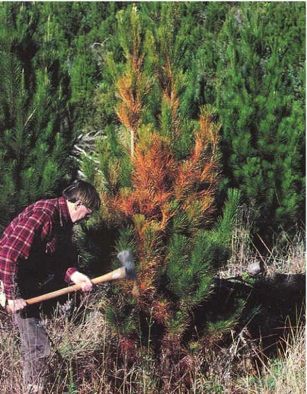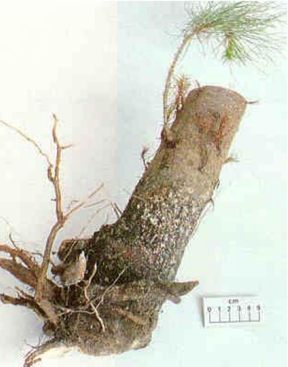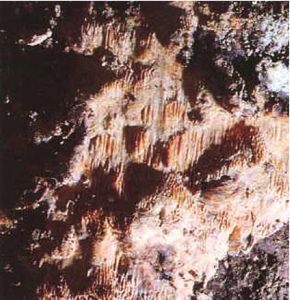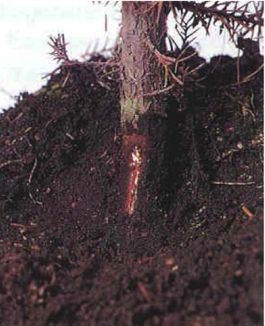PESTS AND DISEASES OF FORESTRY IN NEW ZEALAND
Junghuhnia root disease
Scion is the leading provider of forest-related knowledge in New Zealand
Formerly known as the Forest Research Institute, Scion has been a leader in research relating to forest health for over 50 years. The Rotorua-based Crown Research Institute continues to provide science that will protect all forests from damage caused by insect pests, pathogens and weeds. The information presented below arises from these research activities.
Junghuhnia Root Disease.
Forest Pathology in New Zealand No. 18
Based on M. Dick (1987)
Causal organism
Junghuhnia vincta (Berk.) Hood & M. Dick (= Poria vincta (Berk.) Cooke; = Rigidoporus vinctus (Berk.) Ryvarden)

Fig. 1 - A young Pinus radiata tree exhibiting the characteristic symptoms of junghuhnia root disease:
an uneven distribution of yellowing and browning branches in the crown.
Type of injury
Death of trees, singly or occasionally in small groups.
Diagnostic features
- Progressive yellowing and browning of foliage with older foliage dying first.
- Some branches affected before others, giving tree crowns an uneven, patchy appearance (Fig. 1).
- Small pads of white or pale pink fungal tissue develop on the outside of the bark at the base of the tree, and on roots just below the soil surface (Fig. 2).
- Fruiting bodies in the form of pink encrustations with pores may develop on the lower stem (Fig. 3).
- Vertical, sunken grooves may run a short distance up from the base of the stem.

Fig. 2 - Pads of white and pink fungal tissue produced on bark at the base of a young Pinus radiata tree infected by Juhnghuhnia vincta.

Fig. 3 - Fruiting body of Juhnghuhnia vincta on Pinus radiata stem showing pores.
Host Trees: It is probable that the host range for both parasitic attack and non-parasitic presence is much wider than has been recorded.
- Parasitic attack - Berberis aristata, B. glaucocarpa, Chamaecyparis lawsoniana, Cryptomeria japonica, Cupressus macrocarpa, Solanum betaceum, Cornus capitata, Pinus radiata, Populus alba, P. nigra, Pseudotsuga menziesii, Salix matsudana, Thuja plicata.
- Non-parasitic - Agathis australis, Paraserianthes lophantha, Beilschmiedia tawa, Corynocarpus laevigatus, Dysoxylum spectabile, Hoheria populnea, Nothofagus menziesii.
A pathogenicity test on 2-year-old trees from seven genera (10 species) showed that different hosts vary in their degree of susceptibility to J. vincta . Cryptomeria japonica seedlings in this trial were extremely susceptible (Fig. 4), cypresses (Chamaecyparis lawsoniana, Cupressus macrocarpa, Thuja plicata) were not as badly affected and Pinus radiata plants were, in comparison, only moderately susceptible. Four Eucalyptus species tested were generally unaffected.
Distribution
First recorded in New Zealand in 1886 by Colenso but subsequent records are sparse. Most are from locations north of a line between Gisborne and New Plymouth.
Disease development
In exotic pine plantations mortality caused by J. vincta periodically occurs in areas recently converted from indigenous forest. Trees become infected when a root or part of the stem comes in contact with buried woody material colonised by the fungus, or with roots of an already diseased plant. Infection takes place more readily if the host tissue has been wounded or damaged. The fungus grows slowly within living tissue but once the tissue is killed, a white spongy wood decay rapidly develops. Eventually thin black zone lines develop within the decayed wood, and flecks and small pads of fungal tissue appear on the outside of the bark. Fruiting bodies may form just above soil level.
Mortality due to Armillaria infection was common in young first rotation P. radiata plantations established on sites converted from indigenous forest, and the high incidence of this disease tended to mask the presence of J. vincta . However, crown symptoms differ on trees affected by each disease. Whereas browning is irregular on trees infected by J. vincta, those with Armillaria tend to wilt evenly, becoming a light yellow-green before turning a uniform deep brown. Less resin is produced by J. vincta-attacked pine trees than those infected by other common root pathogens such as Armillaria spp.(Forest Pathology in New Zealand 4), Gloeopeniophorella sacrata (Forest Pathology in New Zealand 3), and Leptographium spp. (Forest Pathology in New Zealand 6).
Junghuhnia root disease also affects trees and woody shrubs established on sites that have not previously held native forest for a long time, such as farmland, and it also occurs in some horticultural and even urban situations. Apparently spores released from fruiting bodies spread the fungus as they disperse, colonise wood debris or stumps, from which infection spreads to living plants, and so
establishes new disease centres.

Fig. 4 - Infected Cryptomeria japonica with bark peeled away showing white mycelium somewhat similar to that produced by Armillaria.
Economic importance
Although the impact of this disease on forestry is difficult to assess, it is probably not great. It is now clear that a small proportion of the mortality attributed to armillaria root disease over the past 50 years was in fact caused by J. vincta. Junghuhnia vincta is one of the fungi responsible for "white crown canker" root disease, which causes mortality of orchard shelterbelt trees in the Bay of Plenty. Exposure to wind through the gaps created in these shelterbelts adversely affects the productivity of subtropical fruit plantings. The fungus may have survived on roots and woody material in the soil after the native forest cover was felled, allowing it to infect live plants or colonise dead woody matter in Berberis glaucocarpa (barberry) hedges, and then spread to the taller shelter belt trees. However, it is also likely that new infection centres may become established by means of spores from nearby residual indigenous forest.
Control
Not investigated, but not considered necessary in view of the probable low incidence of the disease.
Bibliography
Dick, M. 1987: Junghuhnia root disease. New Zealand Forest Research Institute, Forest Pathology in New Zealand No. 18.
Hood, I.A. 2009: Junghuhnia spreads by spores. Forest Health News 198: 1-2.
Hood, I.A.; Dick, M. 1988: Junghuhnia vincta (Berkeley) comb. nov., root pathogen ofPinus radiata. New Zealand Journal of Botany 26: 113-116.
Taylor, B. 1984: White crown canker in shelter belts. New Zealand Ministry of Agriculture and Fisheries, Aglink Horticultural Produce and Practice 131 (3rd edition).
Compiled: 1987; Revised 2009.
This information is intended for general interest only. It is not intended to be a substitute for specific specialist advice on any matter and should not be relied on for that purpose. Scion will not be liable for any direct, indirect, incidental, special, consequential or exemplary damages, loss of profits, or any other intangible losses that result from using the information provided on this site.
(Scion is the trading name of the New Zealand Forest Research Institute Limited.)

 Farm Forestry New Zealand
Farm Forestry New Zealand

